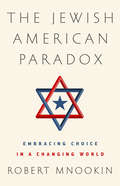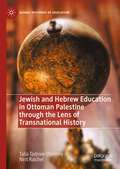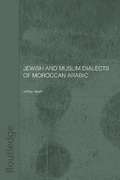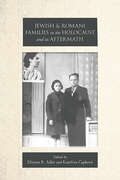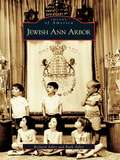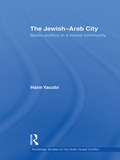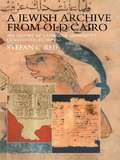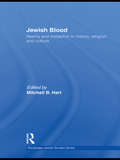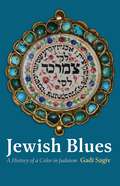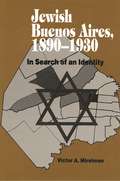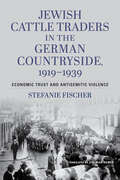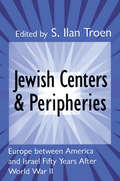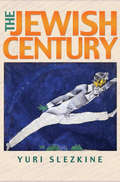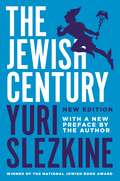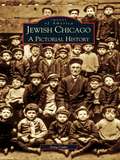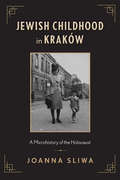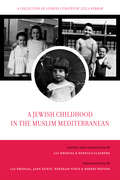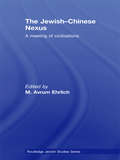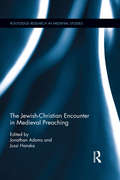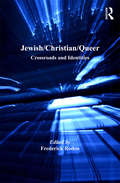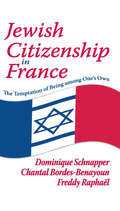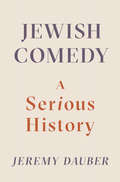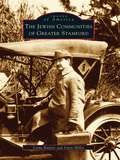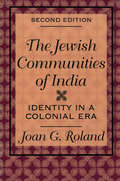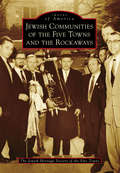- Table View
- List View
The Jewish American Paradox: Embracing Choice in a Changing World
by Robert H. MnookinWho should count as Jewish in America? What should be the relationship of American Jews to Israel? Can the American Jewish community collectively sustain and pass on to the next generation a sufficient sense of Jewish identity? The situation of American Jews today is deeply paradoxical. Jews have achieved unprecedented integration, influence, and esteem in virtually every facet of American life. But this extraordinarily diverse community now also faces four critical and often divisive challenges: rampant intermarriage, weak religious observance, diminished cohesion in the face of waning anti-Semitism, and deeply conflicting views about Israel.Can the American Jewish community collectively sustain and pass on to the next generation a sufficient sense of Jewish identity in light of these challenges? Who should count as Jewish in America? What should be the relationship of American Jews to Israel?In this thoughtful and perceptive book, Robert H. Mnookin argues that the answers of the past no longer serve American Jews today. The book boldly promotes a radically inclusive American-Jewish community--one where being Jewish can depend on personal choice and public self-identification, not simply birth or formal religious conversion. Instead of preventing intermarriage or ostracizing those critical of Israel, he envisions a community that embraces diversity and debate, and in so doing, preserves and strengthens the Jewish identity into the next generation and beyond.
Jewish and Hebrew Education in Ottoman Palestine through the Lens of Transnational History (Global Histories of Education)
by Talia Tadmor-Shimony Nirit RaichelThis book uses transnational history to explain the formation of modern schools in a territory that lacks modern education. The emergence of modern Jewish education in Ottoman Palestine resulted from European actors and networks' infiltration of educational concepts due to several unique elements. One of them was the activity of transnational networks and actors. The other factor is the important place of education in shaping reality in the Jewish and Hebrew discourse. The area of Ottoman Palestine was almost devoid of modern education, so it is possible to examine the ways of transferring educational concepts. Historians can diagnose the starting point and locate the actors’ biographies and journeys. The book discusses and discovers several themes, such as molding five portraits of modern Jewish and Hebrew education graduates and the function of the school as a medical site due to the shortage of public health policy.
Jewish and Muslim Dialects of Moroccan Arabic (Routledge Arabic Linguistics Series)
by Jeffrey HeathThis is a comprehensive study of the Jewish and Muslim dialect networks of Morocco in its traditional boundaries, covering twenty-two Muslim and some thirty Jewish dialects of Moroccan Arabic.
Jewish and Romani Families in the Holocaust and its Aftermath
by Eliyana R. Adler Natalia Aleksiun Viktoria Banyai Laura Hobson Faure Robin Judd Dalia Ofer Anja Reuss Helena Sadílková Joachim Schlör Michal Unger Sarah Wobick-Segev Katerina Capková Volha BartashDiaries, testimonies and memoirs of the Holocaust often include at least as much on the family as on the individual. Victims of the Nazi regime experienced oppression and made decisions embedded within families. Even after the war, sole survivors often described their losses and rebuilt their lives with a distinct focus on family. Yet this perspective is lacking in academic analyses. In this work, scholars from the United States, Israel, and across Europe bring a variety of backgrounds and disciplines to their study of the Holocaust and its aftermath from the family perspective. Drawing on research from Belarus to Great Britain, and examining both Jewish and Romani families, they demonstrate the importance of recognizing how people continued to function within family units—broadly defined—throughout the war and afterward.
Jewish Ann Arbor (Images of America)
by Richard Adler Ruth AdlerThe earliest Jewish settlers arrived in Michigan during the mid-18th century. Primarily traders associated with the burgeoning fur industry, few of these entrepreneurs remained permanently. During the early 1840s, the five Weilbrothers, farmers and tanners from Germany, became the first prominent Jewish settlers in Washtenaw County. By the end of that decade, a Jewish cemetery was established on what is now the site of the Horace Rackham Building on the University of Michigan campus. Though the Weil familyeventually moved west, the cemetery remained as a marker for what was then a miniscule Jewish presence. In the early 20th century, Osias Zwerdling and the Lansky family arrived. In addition to reestablishing a Jewish presence in Ann Arbor, they helped form what became Beth Israel Congregation. Growth of the Ann Arbor Jewish community coincided with the evolution of the university, as well as the city. By the end of the 20th century, a vibrant community representing all facets of Judaism had been established.
The Jewish-Arab City: Spatio-politics in a mixed community (Routledge Studies on the Arab-Israeli Conflict #Vol. 5)
by Haim YacobiMixed city is a term widely used in Israel to describe areas occupied by both Jewish and Arab communities. In a critical examination of such cities, the author shows how a clear spatial and mental division exists between Arabs and Jews in Israel, and how the occurrence of such communities is both exceptional and involuntary. Looking at Jewish-Arab relations in Israel in the context of the built environment, it is argued that there are complex links between socio-political relations and the production of contested urban space. The case study of one particular Jewish-Arab "mixed city", the city of Lod, is used as the platform for wider theoretical discussion and political analysis. This city has great significance in the present global context, as more and more cities are becoming polarized, ghettoized, and fragmented in surprisingly similar ways. This book examines the visible planning apparatuses and the "hidden" mechanisms of social, political, and cultural control involved in these processes. Focusing on the spatialities of power, this book brings to the fore a critical discussion of the urban processes that shape Jewish-Arab "mixed cities" in Israel, and will be of interest to students and scholars of Urban Studies, Middle East Studies and Politics in general.
A Jewish Archive from Old Cairo: The History of Cambridge University's Genizah Collection (Culture and Civilization in the Middle East)
by Stefan ReifExplains how Cairo came to have its important Genizah archive, how Cambridge developed its interests in Hebraica, and how a number of colourful figures brought about the connection between the two centres. Also shows the importance of the Genizah material for Jewish cultural history.
Jewish Blood: Reality and metaphor in history, religion and culture (Routledge Jewish Studies Series)
by Mitchell B. HartThis book deals with the Jewish engagement with blood: animal and human, real and metaphorical. Concentrating on the meaning or significance of blood in Judaism, the book moves this highly controversial subject away from its traditional focus, exploring how Jews themselves engage with blood and its role in Jewish identity, ritual and culture. With contributions from leading scholars in the field, the book brings together a wide range of perspectives and covers communities in ancient Israel, Europe and America, as well as all major eras of Jewish history: biblical, Talmudic, medieval and modern. Providing historical, religious and cultural examples ranging from the "Blood Libel" through to the poetry of Uri Zvi Greenberg, this volume explores the deep continuities in thought and practice related to blood. Moreover, it examines the continuities and discontinuities between Jewish and Christian ideas and practices related to blood, many of which extend into the modern, contemporary period. The chapters look at not only the Jewish and Christian interaction, but the interaction between Jews and the individual national communities to which they belong, including the complex appropriation and rejection of European ideas and images undertaken by some Zionists, and then by the State of Israel. This broad-ranging and multidisciplinary work will be of interest to students of Jewish Studies, History and Religion.
Jewish Blues: A History of a Color in Judaism (Jewish Culture and Contexts)
by Gadi SagivJewish Blues presents a broad cultural, social, and intellectual history of the color blue in Jewish life between the sixteenth and twenty-first centuries. Bridging diverse domains such as religious law, mysticism, eschatology, as well as clothing and literature, this book contends that, by way of a protracted process, the color blue has constituted a means through which Jews have understood themselves.In ancient Jewish texts, the term for blue, tekhelet, denotes a dye that serves Jewish ritual purposes. Since medieval times, however, Jews gradually ceased to use tekhelet in their ritual life. In the nineteenth century, however, interest in restoring ancient dyes increased among European scholars. In the Jewish case, rabbis and scientists attempted to reproduce the ancient tekhelet dye. The resulting dyes were gradually accepted in the ritual life of many Orthodox Jews. In addition to being a dye playing a role in Jewish ritual, blue features prominently in the Jewish mystical tradition, in Jewish magic and popular custom, and in Jewish eschatology. Blue is also representative of the Zionist movement, and it is the only chromatic color in the national flag of the State of Israel.Through the study of the changing roles and meanings attributed to the color blue in Judaism, Jewish Blues sheds new light on the power of a visual symbol in shaping the imagination of Jews throughout history. The use of the color blue continues to reflect pressing issues for Jews in our present era, as it has become a symbol of Jewish modernity.
Jewish Buenos Aires, 1890-1939: In Search of an Identity
by Dr Victor A MirelmanVictor Mirelman, in his study of the greatest concentration of Latin American Jewry, examines the changing facade of the Argentinean Jewish community from the beginning of mass Jewish immigration in 1890 to its decline in 1930. During this period, Jews arrived from Russia, Poland, Romania, Syria, Turkey and Morocco Each group founded its own synagogues. mutual help organizations. hospitals. cultural associations. and newspapers of particular vitality was the Yiddish press and the Yiddish theatre. Jewish immigrants were also especially active politically, particularly in the Socialist Party and in the workers' unions. <P><P> Based on research in the Argentine archives. Jewish Buenos Aires, 1890-1930 describes the immigration and settlement process. studies the first generation of Argentine-born Jews. and provides an understanding of assimilation and acculturation. Mirelman discusses the religious life of the community differentiating between the Ashkenazim and the various Sephardic groups and devotes chapters to Zionism, to Jewish culture in Yiddish. Hebrew. and Spanish. to education; and to social action Issues that created conflict and friction are analyzed in detail.
Jewish Cattle Traders in the German Countryside, 1919–1939: Economic Trust and Antisemitic Violence
by Stefanie FischerJewish Cattle Traders in the German Countryside, 1919–1939, explores the social and economic networks in which this group operated and the informal but durable bonds between Jewish cattle traders and farmers that not even incessant Nazi attacks could break.Stefanie Fischer combines approaches from social history, economic history, and sociology to challenge the longstanding cliché of the shady Jewish cattle dealer. By focusing on trust and social connections rather than analyzing economic trends, Fischer exposes the myriad inconsistencies that riddled the process of expelling the Jews from Germany.Jewish Cattle Traders in the German Countryside, 1919–1939, examines the complexities of relations between Jews and non-Jews who were engaged in economic and social exchange. In the process, Fischer challenges previous understandings of everyday life under Nazi rule and discovers new ways in which Jewish agency acted as a critical force throughout the exclusionary processes that took place in Hitler's Germany.
Jewish Centers and Peripheries: Europe Between America and Israel Fifty Years After World War II
by S. Llan TroenAfter World War II, the centre of gravity for world Jewry moved utside Europe. In the aftermath of the Holocaust, large-scale emigration and post-war assimilation resulted in a disheartening contraction of European Jewry, with the notable exception of France. Today, Europe's Jews number only 17 percent of the world Jewish population. At the beginning of this century, they comprised 83 percent and were the centre of the modern Jewish experience. In a radical reversal, former peripheries became the centres, notably American Jewry, the largest and most dynamic of the Diaspora communities, and the State of Israel. An examination of the altered place of Europe and its future role in Jewish history is long overdue. Jewish Centers and Peripheries examines the dynamic relationship between European, American, and Israeli communities at times bringing personal knowledge of significant events pertinent to understanding the relationships. Collectively they suggest that present conditions are ripe for the re-emergence of European Jewry, though on a scale much diminished from that of the pre-Holocaust period. Moreover, the prospects for the rejuvenation of European Jewry mirror the possibilities for Jewish continuity everywhere. Jewish Centers and Peripheries is a strikingly informative assessment of the condition of world Jewry at the close of the century.
The Jewish Century
by Yuri SlezkineThis masterwork of interpretative history begins with a bold declaration: The Modern Age is the Jewish Age--and we are all, to varying degrees, Jews. The assertion is, of course, metaphorical. But it underscores Yuri Slezkine's provocative thesis. Not only have Jews adapted better than many other groups to living in the modern world, they have become the premiere symbol and standard of modern life everywhere. Slezkine argues that the Jews were, in effect, among the world's first free agents. They traditionally belonged to a social and anthropological category known as "service nomads," an outsider group specializing in the delivery of goods and services. Their role, Slezkine argues, was part of a broader division of human labor between what he calls Mercurians-entrepreneurial minorities--and Apollonians--food-producing majorities. Since the dawning of the Modern Age, Mercurians have taken center stage. In fact, Slezkine argues, modernity is all about Apollonians becoming Mercurians--urban, mobile, literate, articulate, intellectually intricate, physically fastidious, and occupationally flexible. Since no group has been more adept at Mercurianism than the Jews, he contends, these exemplary ancients are now model moderns. The book concentrates on the drama of the Russian Jews, including émigrés and their offspring in America, Palestine, and the Soviet Union. But Slezkine has as much to say about the many faces of modernity--nationalism, socialism, capitalism, and liberalism--as he does about Jewry. Marxism and Freudianism, for example, sprang largely from the Jewish predicament, Slezkine notes, and both Soviet Bolshevism and American liberalism were affected in fundamental ways by the Jewish exodus from the Pale of Settlement. Rich in its insight, sweeping in its chronology, and fearless in its analysis, this sure-to-be-controversial work is an important contribution not only to Jewish and Russian history but to the history of Europe and America as well.
The Jewish Century, New Edition
by Yuri SlezkineThis masterwork of interpretative history begins with a bold declaration: “The Modern Age is the Jewish Age, and the twentieth century, in particular, is the Jewish Century.” The assertion is, of course, metaphorical. But it drives home Yuri Slezkine’s provocative thesis: Jews have adapted to the modern world so well that they have become models of what it means to be modern. While focusing on the drama of the Russian Jews, including émigrés and their offspring, The Jewish Century is also an incredibly original account of the many faces of modernity—nationalism, socialism, capitalism, and liberalism. Rich in its insight, sweeping in its chronology, and fearless in its analysis, this is a landmark contribution to Jewish, Russian, European, and American history.
Jewish Chicago: A Pictorial History (Images of America)
by Irving CutlerFor many years Chicago had the third largest Jewishpopulation of any city in the world. Through the medium of historic photographs, this book captures the remarkable evolution of the Jewish people of Chicago, from their immigrant beginnings in the 1840s to their present-day communities. It is a story of the cultural, religious, economic, and everyday life of Chicago's Jews. These pages bring to life the people, events, neighborhoods, and institutions that helped shape and transform today's Jewish community. The photos and maps, culled from the author's and other collections, paint a vivid and informative picture of Chicago Jewry. In addition to recalling the early immigrant German and later Eastern European Jews, this book delves into Jewish neighborhoods including the West Side, South Side, North Side, suburban communities, and Maxwell Street, a neighborhood which produced such prominent Jews as musician Benny Goodman, U.S. Supreme Court Justice Arthur Goldberg, Admiral Hyman Rickover, community organizer Saul Alinsky, and CBS founder William Paley. Chicago Jews have also made contributions to the city and the nation in the arts,commerce and industry, government service, entertainment, and labor, including seven Nobel prize winners. The images show Jews as peddlers and sweatshop workers as well as successful business entrepreneurs and professionals.
Jewish Childhood in Kraków: A Microhistory of the Holocaust
by Joanna SliwaWinner of the 2020 Ernst Fraenkel Prize from the Wiener Holocaust Library Jewish Childhood in Kraków is the first book to tell the history of Kraków in the second World War through the lens of Jewish children’s experiences. Here, children assume center stage as historical actors whose recollections and experiences deserve to be told, analyzed, and treated seriously. Sliwa scours archives to tell their story, gleaning evidence from the records of the German authorities, Polish neighbors, Jewish community and family, and the children themselves to explore the Holocaust in German-occupied Poland and in Kraków in particular. A microhistory of a place, a people, and daily life, this book plumbs the decisions and behaviors of ordinary people in extraordinary times. Offering a window onto human relations and ethnic tensions in times of rampant violence, Jewish Childhood in Kraków is an effort both to understand the past and to reflect on the position of young people during humanitarian crises.
A Jewish Childhood in the Muslim Mediterranean: A Collection of Stories Curated by Leïla Sebbar (University of California Series in Jewish History and Cultures #2)
by Lia BrozgalA free ebook version of this title is available through Luminos, University of California Press’s Open Access publishing program. Visit www.luminosoa.org to learn more.A Jewish Childhood in the Muslim Mediterranean brings together the fascinating personal stories of Jewish writers, scholars, and intellectuals who came of age in lands where Islam was the dominant religion and everyday life was infused with the politics of the French imperial project. Prompted by novelist Leïla Sebbar to reflect on their childhoods, these writers offer literary portraits that gesture to a universal condition while also shedding light on the exceptional nature of certain experiences. The childhoods captured here are undeniably Jewish, but they are also Moroccan, Algerian, Tunisian, Egyptian, Lebanese, and Turkish; each essay thus testifies to the multicultural, multilingual, and multi-faith community into which its author was born. The present translation makes this unique collection available to an English-speaking public for the first time. The original version, published in French in 2012, was awarded the Prix Haïm Zafrani, a prize given by the Elie Wiesel Institute of Jewish Studies to a literary project that valorizes Jewish civilization in the Muslim world.
The Jewish-Chinese Nexus: A Meeting of Civilizations (Routledge Jewish Studies Series #26)
by M. Avrum EhrlichThe Jewish Chinese Nexus explores through a collection of articles the nexus between two of the oldest, intact, starkly contrasting and most interesting civilizations on earth; Jews and Chinese. This volume studies how they are interacting in modernity; how they view each other and what areas of cooperation are evolving between their scholars, activists and politicians and what talents, qualities and social assets are being recognized on each side for the purpose of cooperation and exchange. Featuring contributions from some of the most important scholars and activists from China and from around the Jewish Diaspora, the essays purview China related themes including the fascination of Chinese with Jews and Judaism and its potential value in Chinese national and religious reconstruction; religious and ethnic identity; East – West interactions. It deals with the growing Jewish community in China and its impact as well as the development of Jewish studies in China and the translation of Jewish texts into Chinese and their impact. The work is a first of its kind, identifying an emerging meeting point between these two people and arguing that despite the giant contrasts in their national constructs they have nonetheless other important patterns and themes in common which pave the way for fruitful cooperation and mutual respect.
The Jewish-Christian Encounter in Medieval Preaching (Routledge Research in Medieval Studies #6)
by Jonathan Adams Jussi HanskaThis book explores the complexity of preaching as a phenomenon in the medieval Jewish-Christian encounter. This was not only an "encounter" as physical meeting or confrontation (such as the forced attendance of Jews at Christian sermons that took place across Europe), but also an "imaginary" or theological encounter in which Jews remained a figure from a distant constructed time and place who served only to underline and verify Christian teachings. Contributors also explore the Jewish response to Christian anti-Jewish preaching in their own preaching and religious instruction.
Jewish/Christian/Queer: Crossroads and Identities (Queer Interventions Ser.)
by Frederick RodenAt a time when major branches of Judaism and most Christian denominations are addressing the relationship between religion and homosexuality, Jewish/Christian/Queer offers a unique examination of the similarities between the queer intersections of Judaism and Christianity, and the queer intersections of the homosexual and the religious. This volume investigates three forms of queerness; the rhetorical, theological and the discursive dissonance at the meeting points between Christianity and Judaism; the crossroads of the religious and the homosexual; and the intersections of these two forms of queerness, namely where the religiously queer of Jewish and Christian speech intersects with the sexually queer of religiously identified homosexual discourse. Including essays on literature and literary theory, Christian theology, Biblical, Rabbinic, and Jewish studies, queer theory, architecture, Freud, gay and lesbian studies and history, Jewish/Christian/Queer will have a truly interdisciplinary appeal.
Jewish Citizenship in France: The Temptation of Being Among One's Own
by Chantal Bordes-BenayounThe Jews of France have been liberated for over two centuries; they have been considered free citizens and equal to their compatriots. What purpose, then, does it serve to study their citizenship today? Until World War II, French Jews called themselves ""Israelites;"" they were deeply patriotic and had found a place for themselves in France's ""community of citizens."" However outbursts of anti-Semitism during that period reminded them that their new status prevented neither hate nor rejection; they had to persevere in the struggle for citizenship equity.France has not been spared from recent movements demanding recognition of particular identities in the public space. Ethnicity in French political life has become increasingly obvious, in spite of the constant assertion of ""republican values."" Questions about immigration, nationality, and integration are constantly in the forefront of public life. Though, in France, the existence of ethnic and religious communities is not legally recognized, certain groups are designated as separate, often creating conflicts among them.
Jewish Comedy: A Serious History
by Jeremy DauberFinalist for the National Jewish Book Award A rich account of Jewish humor: its nature, its development, and its vital role throughout history. In a major work of scholarship both erudite and very funny, Columbia professor Jeremy Dauber traces the origins of Jewish comedy and its development from biblical times to the age of Twitter. Organizing the product of Jews’ comic imagination over continents and centuries into what he calls the seven strands of Jewish comedy—including the satirical, the witty, and the vulgar—he traces the ways Jewish comedy has mirrored, and sometimes even shaped, the course of Jewish history. Persecution, cultural assimilation, religious revival, diaspora, Zionism—all of these, and more, were grist for the Jewish comic mill; and Dauber’s book takes readers on the tour of the funny side of some very serious business. (And vice versa.) In a work of dazzling scope, readers will encounter comic masterpieces here that range from Talmudic rabbi jokes to medieval skits, Yiddish satires and Borscht Belt routines to scenes from Seinfeld and Broad City, and the book of Esther to Adam Sandler’s “Hanukkah Song.” Dauber also explores the rise and fall of popular comic archetypes such as the Jewish mother, the Jewish American Princess, and the schlemiel, the schlimazel, and the schmuck, and the classic works of such masters of Jewish comedy as Sholem Aleichem, Isaac Babel, Franz Kafka, the Marx Brothers, Woody Allen, Joan Rivers, Philip Roth, Mel Brooks, Sarah Silverman, Jon Stewart, and Larry David, among many others. Jewish comedy, as Dauber writes, is serious business. And precisely what it is, how it developed, and how its various strands weave together and in conversation with the Jewish story: that’s Jewish Comedy.
Jewish Communities of Greater Stamford, The (Images of America)
by Linda Baulsir Irwin MillerThe Jewish Communities of Greater Stamford presents a broad historical view of the Jewish people of Stamford, Darien, Greenwich, and New Canaan, Connecticut, and Pound Ridge, New York. The book goes back to the era just prior to the American Revolution, when lone Jewish families settled among the Connecticut Yankees to engage in trade, manufacturing, and commerce.The earliest settlers-such as Nehemiah Marks, who was living and doing business in Stamford as early as 1720-opened stores and other commercial enterprises. By the mid-1800s, city dwellers began coming to the region for summer vacations. After 1880, settlers arrived via the peddlers' routes and, after accumulating a little capital, stayed to open shops and establish themselves socially and politically. The greatest influx came in the 1890s and early 1900s, when many Jews arrived from the Pale of Settlements, eastern and central Europe, Lithuania, Poland, Russia, Romania, and the Austro-Hungarian Empire.
Jewish Communities of India: Identity in a Colonial Era
by Joan G. RolandAlthough the Bene Israel community of western India, the Baghdadi Jews of Bombay and Calcutta, and the Cochin Jews of the Malabar Coast form a tiny segment of the Indian population, their long-term residence within a vastly different culture has always made them the subject of much curiosity. India is perhaps the one country in the world where Jews have never been exposed to anti-Semitism, but in the last century they have had to struggle to maintain their identity as they encountered two competing nationalisms: Indian nationalism and Zionism. Focusing primarily on the Bene Israel and Baghdadis in the late nineteenth and twentieth centuries, Joan Roland describes how identities begun under the Indian caste system changed with British colonial rule, and then how the struggle for Indian independence and the establishment of a Jewish homeland raised even further questions. She also discuses the experiences of European Jewish refugees who arrived in India after 1933 and remained there until after World War II.To describe what it meant to be a Jew in India, Roland draws on a wealth of materials such as Indian Jewish periodicals, official and private archives, and extensive interviews. Historians, Judaic studies specialist, India area scholars, postcolonialist, and sociologists will all find this book to be an engaging study. A new final chapter discusses the position of the remaining Jews in India as well as the status of Indian Jews in Israel at the end of the twentieth century.
Jewish Communities of the Five Towns and the Rockaways (Images of America)
by The Jewish Heritage Society of the Five TownsThe Five Towns--comprising the villages of Cedarhurst and Lawrence and the communities of Woodmere, Hewlett, and Inwood--is an area nestled on the South Shore of Long Island next to the easternmost part of Queens, known as Far Rockaway. Originally popular as a Jewish summer vacation spot near the Atlantic Ocean, the Five Towns and the Far Rockaway area grew to become a thriving, year-round Jewish metropolis, with thousands of families and scores of synagogues and Jewish educational institutions. A center for shopping and kosher restaurants, the Five Towns area has become one of the most popular locations for young, married Jewish couples. Jewish influence has expanded greatly in local government and education. The rich history of the early years of Jewish growth and development in the Five Towns and Rockaways lends a deeper understanding of this phenomenal change of demographics and influence that has occurred over the last few decades.
